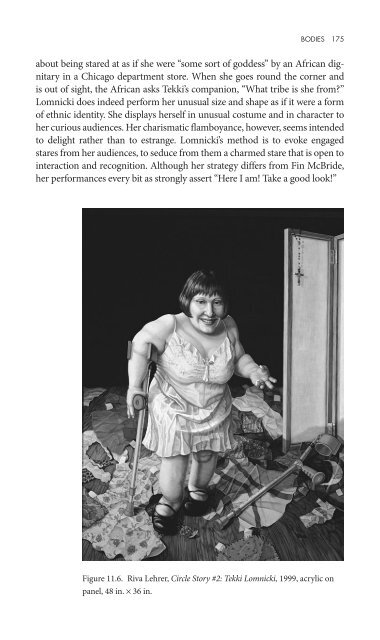Staring how we look sobre la mirada.pdf - artecolonial
Staring how we look sobre la mirada.pdf - artecolonial
Staring how we look sobre la mirada.pdf - artecolonial
You also want an ePaper? Increase the reach of your titles
YUMPU automatically turns print PDFs into web optimized ePapers that Google loves.
LOOKING AWAY, STARING BACK 83<br />
g<strong>la</strong>nce, she <strong>look</strong>s like a modern Florentine <strong>la</strong>dy. On second g<strong>la</strong>nce, <strong>how</strong>ever,<br />
<strong>we</strong> recognize a face <strong>we</strong> have never seen in a portrait. We see the distinct features<br />
of a person with Down syndrome, her hair wrapped in a bright beach<br />
to<strong>we</strong>l, her face in a faraway reverie, and a simple heart tattooed on her shoulder<br />
below her bathing suit strap. The portrait invites us to stare, engrossed<br />
perhaps less with the “strangeness” of this woman’s disability and more with<br />
the strangeness of witnessing such dignity in a face that marks a life <strong>we</strong> have<br />
learned to imagine as unlivable and unworthy, as the kind of person <strong>we</strong> routinely<br />
detect in advance through medical technology and eliminate from our<br />
human community.<br />
In The Body Silent (1987), anthropologist Robert Murphy, who conducted<br />
fieldwork on his own experience of quadriplegia, points out that <strong>look</strong>ing<br />
away from people who make us uncomfortable differs from granting them<br />
visual anonymity. Looking away is an active denial of acknowledgment<br />
rather than the tacit tipping of one’s hat to ordinary fellow citizens expressed<br />
in simply not noticing one another. Looking away is for Murphy a deliberate<br />
obliteration of his personhood. “[A] wheelchair cannot be hidden,” he notes,<br />
“it is brutally visible” (93). People refuse to <strong>look</strong> at Murphy, he concludes,<br />
partly because they know that they are not supposed to stare at him and have<br />
no easy way to re<strong>la</strong>te to him. Having been on both sides of stares, Murphy<br />
writes of his own “selective blindness” before becoming disabled, contending<br />
that a disabled person entering his “field of vision” would not register in<br />
his consciousness. After he began using a wheelchair, <strong>how</strong>ever, he saw that<br />
sociality bet<strong>we</strong>en nondisabled and disabled people is “tense, awkward, and<br />
problematic,” and that this is often expressed through ocu<strong>la</strong>r evasion. The<br />
newly quadriplegic Murphy found that acquaintances “did not <strong>look</strong> [his]<br />
way” and that he was “virtually ignored in crowds for long periods, broken<br />
by short bursts of patronization” (91). This “pattern of avoidance” begets<br />
feelings of shame and guilt which initially erode Murphy’s dignity and selfesteem<br />
(91). Murphy’s subtle analysis of the social message that <strong>look</strong>ing and<br />
<strong>look</strong>ing away sends to starees suggests that recuperating the dignity lost in<br />
such exchanges is a demanding task for people with disabilities.<br />
Conferring dignity on people whose differences draw stares is the challenge<br />
to which these portraits of disabled people rise. These portraits intervene<br />
bet<strong>we</strong>en starees and starers to offer respectful, even beautiful, pictures<br />
of people <strong>we</strong> have not learned to <strong>look</strong> at in this way. They revalue devalued<br />
people, the kinds of people most of us have only glimpsed in institutions or in<br />
medical pictures with b<strong>la</strong>ck boxes over the eyes. This anonymity that medical<br />
photographs impose on a staree also prevents the person pictured from staring<br />
back at the vie<strong>we</strong>r. Auld’s and Rush’s portraits rework the way <strong>we</strong> usually<br />
stare, <strong>how</strong>ever. They keep us <strong>look</strong>ing rather than <strong>look</strong>ing away. They grant<br />
us more than permission to stare; they use the clout of high art to transform


